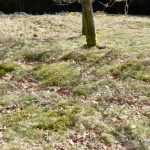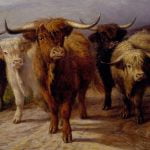The highest of the Mounth Roads that cross the Cairngorms.
The Monega Pass is the most westerly of the Mounth passes. The name ‘mounth’ being an Anglicised form of the Gaelic ‘monadh’ which translates as moor, heath or mountains and the highest old droving route and right of way path in Scotland.
Like many of the Mounth roads, the Monega is named after a hill that it crosses. The pass summits the Monega Hill at an impressive 908m, then continues upward along the Little Glas Maol (973m) before halting slightly short of the summit of Glas Maol, at a staggering 1,068m above sea level.
As a footpath, the Monega is, and has always been, a challenging undertaking. The weather and elevation render the road largely impassable for a significant portion of the year. As such, it is not depicted on any of the standard old maps, which means the Monega was a dangerous shortcut, or a route of last resort, rather than a regularly travelled road.
If the weather was questionable, then a sensible alternative for travellers was to head west to the Cairnwell pass, which had two sheltering hostels en route.
Drovers from Badenoch herding cattle to market in Bridgend of Lintrathen often used the Monega pass in the 17thc. After the Bridgend market closed, they still used the Monega to travel to the fair at Kirkton of Glenisla. The Monega was, therefore, the last leg in a series of well-known drove roads from Badenoch, which passed through Glen Feshie to Braemar, then down to Glen Clunie. Here drovers faced the choice of traveling the riskier, but shorter, Monega Pass or the safer, but longer, Cairnwell.
While the Monega’s ancient history is difficult to discern, its more recent history is well documented. The surrounding area was a favourite place for Queen Victoria to tour with Prince Albert and her ‘particular ghillie’, John Brown. Her diaries recall an outing with her husband, in which they ascended the Cairngorm Plateau from Balmoral via Loch Callater and Jock’s Road. The expedition lingered fondly in the Queen’s memory for many years afterward, as it was one of her last outings with Prince Albert before his untimely death two months later.
As the Monega is such a challenging route, it is tempting to think the local name stemmed from the Gaelic ‘bruid’ or ‘beast,’ but it is more likely to originate in the more prosaic ‘bruthach’, which means a ‘steepness’ or ‘acclivity.’ Therefore, the practical locals knew the route as either ‘the road past Month Eigie’ or ‘the very steep road.’ Either way, their directness was most accurate.



